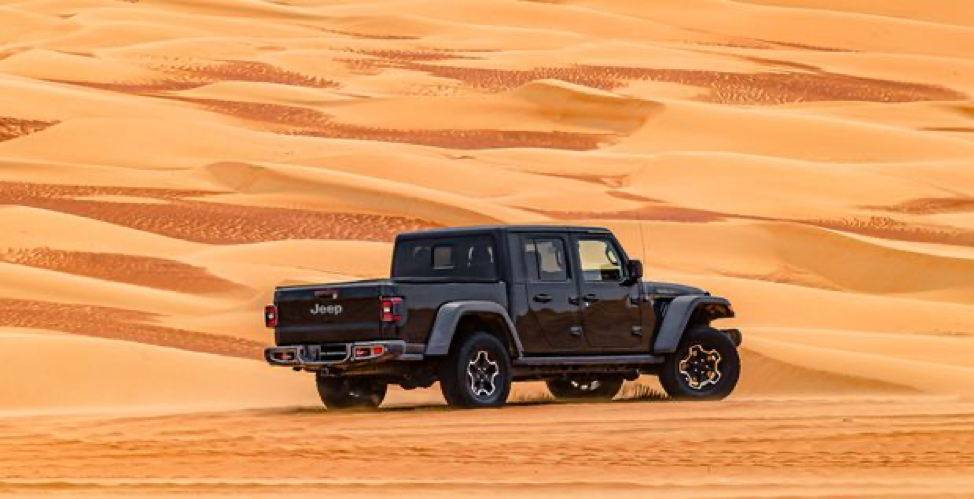
Does naming a car after a Native American tribe cause a problem? Many automotive manufacturers name their vehicles after Native American terms (Grand Cherokee, Pontiac Aztek, etc.). Within the recent months, major companies have considered renaming their products and even their brand.
As reported by Wall Street Journal on June 26th, 2020 by Dan Neil.
Why Jeep Should Change Its Problematic Monikers
AFTER THE DISCORD of the past months, it’s a safe bet white Americans are more alert to racism embedded in the dominant culture and language. With that I serve up the Jeep Gladiator Mojave 4X4, an extreme off-road pickup that name-checks an indigenous people throttled by the U.S. military in the 19th century.
I know, right? Jeep buyers surely prefer to conjure mental images of the eponymous California desert, or river, or maybe a colorful headband. After all, anyone who plunks down $58,760 (as tested) on this 1:1 scale Tonka toy is trying to escape reality, not embrace it.
Auto history is filled with cringey cultural appropriations and monuments to maniacs.
Alas, the Mojave tribe was vanquished and scattered so that today only remnants of the culture remain. I’m not suggesting consumers cancel Jeep on this account. Hell, their last pickup was called the Comanche (1986-1992); reaching back to revive the Gladiator name (1963-1987) was definitely a step in the woke direction. The “Mojave” is just a package of extreme off-road equipment. Ethnocentrism optional.
Glance in the rearview mirror: Auto history is filled with cringey cultural appropriations and monuments to maniacs: La Salle, de Soto, Cadillac. Here’s double trouble: Pontiac Aztek. The former was an Ottawa chief who died in a knife fight; the latter, a civilization (Aztec) obliterated by Spanish guns, germs and steel. Now both names will be forever Google-linked with “Breaking Bad.”
A key feature of this history is that the commonly accepted names of peoples aren’t protected by copyright. Native American cultures thus provided a rich trove of rights-free Americana for Madison Avenue to exploit, from the Arapaho to the Zuni. Among automobiles, these appropriations include Chevrolet’s use of Apache and Cheyenne names, now both retired.
The most conspicuous survivor, the Washington Redskins of nameplates, is Jeep Cherokee/Grand Cherokee. With more than 380,000 members, the Cherokee Nation is the largest tribe in the U.S.; Jeep has sold millions of vehicles with the name on it. But Jeep doesn’t pay for the privilege, said Cherokee Nation Principal Chief Chuck Hoskin Jr. in an email.
In 2013, Jeep doubled down on the Cherokee name, reviving it for a compact SUV, the little brother to the Grand Cherokee. By then Jeep execs would have certainly been aware of the sensitivities around ethnic stereotyping and cultural appropriation. It’s an open question whether Jeep of 2020 would read the tea leaves the same.

PHOTO: JEEP
“The vehicle names in question have been carefully chosen over the years to honor and celebrate Native American peoples for their nobility, prowess and pride,” Fiat Chrysler Automobiles, owner of Jeep brand, said in a statement. “We have never—nor would we ever—do anything to disparage any group of people, and we have never received any feedback that the use of these names is in any way negative.”
Said Chief Hoskin: “We hope the movement away from using tribes’ names and depictions or selling products without our consent, continues. We much prefer a cooperative effort than an adversarial one.”
As the name of both a landscape and a people, Mojave is a little more nuanced. It seems OK to name a vehicle after a place, like the Sahara, but maybe not to objectify an ethnicity—e.g., VW’s Touareg, a marketing cognate of Tuareg, who are a nomadic people in the Sahara. A bit to colonial, that.
If you think I’m making too much of these deliberations, you obviously don’t work in marketing. One of the reasons car makers migrated to alphanumeric model designations is that, after more than a century of production and global copyright law, so many of the good names have been taken and others—Dodge La Femme, Studebaker Dictator, MG Midget or Ford Thunderbird—have become obsolete or otherwise poisoned.
Oh, and by the way, most gladiators were slaves. Just saying.
I wish I could tell you how those two-stage Fox dampers handle hip-high boulder fields. Our blazing-red test truck arrived while my home state of North Carolina was in virtual lockdown. However, I did give the Gladiator a proper thrashing last year in Northern California. Nothing has changed except the prices, which are a tic more outrageous.
Most of my driving time was spent running essential errands, including a trip to the feed store, where the Gladiator sent the urban-chicken enthusiasts into a clucking frenzy. Effectively a four-door Wrangler 4X4 with a 5.5-foot pickup bed, the Gladiator is insanely charismatic, bandy and badass, with an up-armored underbelly, 11 inches of ground clearance and 33-inch all-terrain tires. From my observations the appeal is limited to the 3-through-100 age demographic.
As a toy to admire, it’s tops. As a daily driver, the body-on-frame Gladiator is a horror show, a dark place of disappointment and depreciation. To anyone so inclined, I just ask, Why? It’s loud of tire and wind howl. It’s kind of sluggish, despite a 4.10 rear end, eight-speed automatic and a 285-hp V6. According to the EPA it averages 19 miles to the gallon, but they must be using bigger gallons than me. I was getting about 17 mpg.
And driving one every day would be like living your life dressed as Woody from “Toy Story.”
It’s a little late to be making reparations to the Aztecs, or gladiators, for that matter. But the Mojave’s heirs would seem to have a claim on Jeep’s conscience. Perhaps in the spirit of the times, Jeep could make a donation to Arizona State University’s Center for Indian Education. I suggest for every one sold, donate the price of the optional trailer hitch ($350).
To help with the baggage.
2020 Jeep Gladiator Mojave 4×4
Base Price: $43,875
Price as Tested: $58,760
Powertrain: Naturally aspirated, 3.6-liter 60-degree V6; six-speed manual transmission or eight-speed automatic; two-speed transfer case; electronic locking front and rear differentials; part-time selectable four-wheel drive
Power/Torque: 285 hp at 6,400 rpm/260 lb-ft at 4,400 rpm
Length/Width/Height/Wheelbase: 218.0/75.0 (soft-top)/73.8/137.3 inches
Cargo Box Volume: 35.5 cubic feet
Curb Weight: 4,672-5,050 pounds
0-60 mph: 8 seconds (estimated)
EPA Fuel Economy: 16/23/19 mpg (manual); 17/22/19 mpg (automatic)
Should Jeep donate money to Indian education centers? Should they retire vehicles named after Native American terms? Or should they continue what they are doing?
Additional Brand Naming Resources
Car Brand Naming is a Tricky Category (Ideas BIG)
Naming Your Brand? Use These Pointers to Get it Right (Entrepreneur)
Brand Innovation 101 (Ideas BIG)




